and historical purposes, all rights reserved.
This page is copyright© by
This page may not be sold or distributed without
the expressed permission of the producer.
I have no connection with any camera Co.
PENTACON six TL
On-line users manual
posted April 21, 2003
This camera manual library is for reference
and historical
purposes, all rights reserved.
This page is copyright© by
![]() , M. Butkus,
NJ.
, M. Butkus,
NJ.
This page may not be sold or distributed without
the expressed
permission of the producer.
I have no connection with any camera Co.
On-line camera manual library
Back to main on-line manual page
If you find this manual
useful,
how about a donation of $3 to:
M. Butkus, 29 Lake Ave.,
High Bridge, NJ 08829-1701
and send your
e-mail address
so I can thank you.
Most other places would charge
you $7.50 for a electronic copy
or $18.00 for a hard to read Xerox copy.
If you use Pay Pal, use the link below.
Use the above address for a check, M.O. or cash.
Pentacon Six TL PDF from manual
Pentacon Six TL Bedienungsanleitung
Pentacon Six TL istruzioni per l'uso
Pentacon Six TL Navod K obsluze
PENTACON six TL
PDF manual made from this HTML page
Important parts of the camera
Pentacon Six TL TTL Prism

 |
1. Finder hood 2. Rapid wind lever 3. Disconnecting lever 4. Shutter release 5. Winding lever for delayed-action mechanism 6. Flash socket
|
 |
7. Latch for camera back
8. Counter support for spool 9. Knob for opening the finder hood 10. Frame finder (sports finder) 11. Knob for unlocking finder hood
|
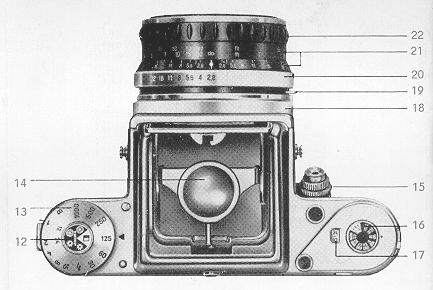 |
12. Film type setting dial
13. Speed setting dial 14. Magnifier lens for focusing 15. Locking ring for shutter release 16. Film speed setting dial 17. Exposure counter 18. Milled ring for fixing the lens 19. Lever for checking depth of field 20. Diaphragm setting ring 21. Depth-of-field scale 22. Focusing ring
|
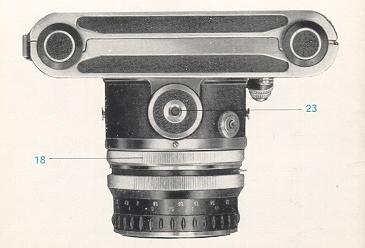 |
18. Milled ring for fixing the lens
23. Tripod socket |
We are extremely pleased that you hove chosen the genuine single lens reflex
camera PENTAGON six TL and wish you every success in your photographic
activities with this camera.
The PENTAGON six TL carries on the great tradition of the genuine single lens
reflex cameras in the 6 x 6 cm (2 1/4 in. square) format.
Its special features are:
Clearly arranged operating controls, shutter release in anatomically correct
position, interchangeable viewfinders (including TTL Prism Attachment) and
focusing screens, click stop shutter speed settings from 1 sec. to 1/1000 sec.
and B (geometrically graduated), designed for 120 roll film (12 frames) or 220
roll film (24 frames), automatic exposure counter with locking device for the
film in use, focal-plane shutter of rubberized material.
X synchronization for electronic flash and bulbs, locking device for flash plug,
wide range of accessories for every kind of photographic
activity, interchangeable lenses, with bayonet fitting and locking ring, from 50
mm to 1000 mm focal length, up to 180 mm with automatic spring diaphragm.
External view of the camera: Unfold the two inside pages of the front and back
covers and look at the camera itself in the same position as it is shown in the
pictures of the instruction booklet. The important parts are marked by numbers
and explained on the page.
Abridged Instructions
6. Release the shutter and wind it again four times. The rapid wind lever must be swung without interruption as far as it will go and moved back. The exposure counter (17) shows the mark for picture 1.
7. Employ viewfinder image for focusing. Critical focusing is performed by means of the magnifying lens.
8. After the 12th and (in case of roll film 220) the 24th exposure, the winding mechanism is locked. It is released by means of disconnecting lever (3), whereupon film transporting can be continued.
9. In case of premature removal the film has to be wound up to the end with
the paper trailer by f u 11 swings of the rapid wind lever and subsequent
releasing of the shutter. Short rocking movements of the rapid wind lever must
not be performed before the 12th exposure has been made.
(see also Section 4).
To achieve faultless advancement of the film, special attention must be paid
to the following 3 points:
1. Remove the gumstrip and insert the paper leader carefully into the middle of
the spool. It must not brush against either one of the spool flanges (Fig. 1).
If this happens, the film will not advance properly. There is even the
possibility of the receiving spool getting jammed within the spool chamber
because of the irregular winding of the film, and the film transport mechanism
might be overstrained on actuation of the winding lever.
2. The paper leader, when being wound up, must lie tautly on the core of the
receiving spool. This can be achieved by slightly suppressing the movement of
the full spool on the supply side with the thumb of the left hand (Fig. 2). Make
sure that the paper windings are not too loose on the take-up spool (Fig. 3)
since this might cause overlapping or excessive spacing between frames. The
first exposure could, in such a case, be made before the film is in the picture
gate;
3. The short rocking movements of the rapid wind lever when
advancing the film, which are mentioned in this instruction booklet, may be
performed only under the following conditions:
a) when the film is being inserted, as long as the camera back is still open,
and
b) after exposure of the 12th frame and subsequent release of the locking device
to permit further advancement of the film.
Thus, if for instance a roll film 120 is to be removed from the camera after the
10th exposure, the shutter has to be wound and released normally up to the 12th
frame. Then, when the locking device of the transport mechanism has been
released, the film can be wound on to the end by short rocking movements. In
this manner you may also advance any 220 roll film after the 13th frame by
rocking it to the end.
Exposure counter
| The exposure counter (17) jumps back to its starting point when the camera back is opened and is automatically set when the camera back is closed. The shutter has to be released and wound again four times, whereupon the mark for picture 1 will appear in the exposure counter. Do not let the winding lever jump back but move it back smoothly. At every subsequent winding of the shutter the counting mechanism advances to the next number. After the 12th and, in case of roll film 220, after the 24th exposure, the winding mechanism is locked. It has to be released again by actuation of disconnecting lever (3). The rapid wind lever can then be fully swung around again steadily and without interruption. |
 |
Film reminder dial
Film reminder dial (12) bearing the symbols for
black-and-white and color film, is mounted above the speed setting
dial (13). The symbol required is set for roll film 120 against the
numeral 12 and for roll film 220 against the numeral 24 on the speed
setting dial. A second film reminder dial (16) marking the film speed
in DIN and ASA readings is positioned above the rapid wind lever.

The finder hood (1) opens and springs into operating
position as soon as you push knob (9) in the direction of the arrow.
It is closed by finger-tip pressure an the cover. The finder hood is
automatically locked on to the camera. To remove it, depress unlocking
knob (11) on the camera top. The hood can then be pushed towards the
back and lifted off.

The magnifier in the finder hood is designed for
critical focusing | and to facilitate picture composition. The
magnifying lens (14) yielding a fourfold enlargement may be swung into
position. The magnifier in the finder hood is designed for critical
focusing | and to facilitate picture composition. The magnifying lens
(14) yielding a fourfold enlargement may be swung into position
parallel with the image field lens. The sports finder is moved into
working position by lifting the inner part of the finder hood cover
and pulling out the frame (10).

Pentaprism
The Pentaprism permits viewing the image at eye level.
It is inserted in place of the finder hood. The reflex image then
appears with sides unreversed and enlarged approximately 2.5 times.
Persons with faulty eyesight may insert a corrective lens into the
eyepiece of the viewfinder to replace their spectacles. You pull the
two lateral catches simultaneously towards the back and place the
pentaprism on the four connecting pins on top of the camera, then
release the catches, and the pentaprism snaps in. Removing the I prism
is performed accordingly.
TTL Prism--please refer to "Accessories".

Focusing takes place with the mirror swung into
viewing position, i.e. with the shutter wound up. Rotate focusing
ring (22) on the lens mount until the image of the subject appears
sharp on the field lens. Distance and definition may also be set by
means of the scale on the lens mount, in which case the field lens
serves only for determining picture composition. The depth of
definition can be read from the focusing ring with the help of
depth-of-field scale (21). Engraved on the left and right of the
index mark on the depth-of-field scale are diaphragm numerals. At
the f/8 setting, for instance, the depth of sharpness can be read
from the focusing ring between the two diaphragm numerals "8" on the
depth-of-field scale.
III.: Distance 5 m (17 ft.), diaphragm setting f/8, depth of
sharpness 3.5 m to approx. 9.5 m = approx. 11 1/2 to 30 ft.
When using the sports finder, focusing has to be performed
beforehand, either on the image field lens or by the scale of the
focusing ring.

Image field lenses 1. Groundglass field lens (Order No. 207250)
7 different image field lenses are available for the
PENTAGON six TL (see also the Instruction Booklet describing
,,Close-up Equipment for PRAKTISIX and PENTAGON six"). The field
lenses are exchanged as follows: Remove the finder element from the
camera and then loosen the screws on the three retaining springs
with a screw driver. Swing the springs aside, take out the spring
ring, and tip the image lens out of the camera. Fixing any one of
the other field lenses is performed in reverse order. It is
important to note that the thinner part of field lenses made of
glass must lie towards the back of the camera. Please also note that
different supporting angle pieces and spring rings are provided for
the Fresnel lens and for the other image field lenses.
2. Groundglass field lens with clear spot and hairline cross (Order No. 207330)
3. Groundglass field lens with reticular guide lines (Order No.
207340)
4. Clear glass field lens with hairline cross, 5 mm reticular
(Order No. 207350)
5. Groundglass field lens with hairline cross, 5 mm reticular
(Order No. 207360)
6. Groundglass field lens with rangefinder wedges (Order No.
207370)
7. Fresnel lens with microprism screen and Groundglass circle
(Order No. 207251)

The rangefinder wedges correspond in effect to a
split-image rangefinder. The rangefinder lens forms two part
images. These are moved towards or away from each other by
rotation of focusing ring (22). If the outlines join precisely
where the two sections meet, the image is in correct focus. This
can be observed best on straight vertical lines.
(7) Fresnel lens (see page 16).

Fresnel lens with microprism screen Correct focusing is achieved as soon as the image in the microprism screen
looks clear and free from fuzziness. The image is out of focus if it looks fuzzy
or crumbles into screen elements. Focusing is extremely reliable since you see
very distinctly the difference between sharpness and unsharpness. Focusing
should be performed with the lens aperture wide open (small diaphragm numeral).
2. Focusing on the groundglass circle
The circular groundglass screen is used preferably in connection with small
lens apertures (large diaphragm numerals) or in case of greater scales of
reproduction as, for instance, in close-up or macro photography. The remaining
section of the viewfinder (Fresnel lens) is not meant for focusing.
top picture-
correct bottom picture- incorrect
The PENTAGON six TL can be supplied, as desired
either with a Fresnel lens for extra image brightness and
microp;ism screen, or with a groundglass image field lens.
1. Focusing on the microprism screen

Focusing with the microprism screen

The diaphragm
The diaphragm is set by rotation of the
diaphragm ring (20) on the lens mount The diaphragm numeral
required for the exposure has to be brought to meet the red
index mark. Lenses with automatic spring diaphragm allow for
full aperture focusing. Not until the shutter is released does
the diaphragm close down to the pre-set value. To check the
depth of field during focusing, you simply depress lever (19) on
the lens mount. This causes the diaphragm to close down to the
value preselected by means of setting ring (20).

The focal-plane shutter of the PENTAcON six TL
gives exposure speeds ranging from 1 sec. to 1/1000 sec. and B
(any desired duration). For exposure speeds of longer than 1
sec. it is advisable to use a special wire release with locking
device. The speeds are graduated so that each figure indicates
double, or one half of the speed marked by the next figure on
the scale. The diaphragm scale works analogously. If the light
value is to be maintained, the next smaller aperture has to be
employed for twice the exposure time, or vice versa.

The exposure speeds
The exposure speeds may be set either before or
after the shutter has been wound. The speed setting dial (13) is
rotatable in either direction. The desired exposure speed figure
must come to stand against the red triangular mark. The speed
settings click in as a safeguard against unintentional
displacement.

Rapid wind lever
The rapid wind lever serves not only to wind the
shutter but simultaneously to transport the film. By this same
performance the diaphragm is set to its widest aperture, the
exposure counter switched to the next number, and the mirror
swung away to allow the light rays to reach the image field
lens.

Delayed-action mechanism- Shutter release
The delayed-action mechanism is tensioned by
swinging the winding lever (5) through about 90 degrees and set
in motion by actuation of shutter release (4). The shutter must
be wound beforehand. The self-timer runs for approx. 10 seconds.
It may be employed with all shutter speeds.
The shutter release is locked by turning the lower milled ring
(15) on the release knob (4) anti-clockwise as far as it will go
(the red dot must be at the top) Inadvertent tripping of the
shutter is thus made impossible. The shutter mechanism is
unlocked by turning the milled ring back again.
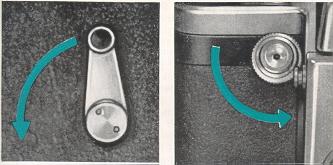
Synchronization
Synchronization with electronic flash and flash
bulbs is effected by means of the X contact. The flash socket
(6) is built into the lower part of the camera front. Clockwise
rotation of the milled ring on the flash socket keeps the flash
plug locked in position. When inserting or removing the flash
plug make sure that the red dot on the milled ring stands
opposite the red dot on the front of the flash socket. For the
use of electronic flash, the speed setting dial must be moved to
the (lighting bolt) setting, for fast-burning bulbs to 1/15
sec., and for bulbs of a longer flash duration to 1/8 sec. For
delayed-action exposures the shutter release has to be depressed
until the flash lights up. (Use cable release with locking
device). The correct diaphragm setting is found by dividing the
guide number of the flash by the flash-to-subject distance
figure.
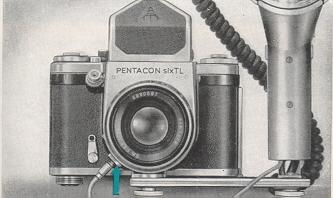
Removing the film
Now open the camera back, pull out the spool support and lock it
in position. Tip the spool with the exposed film into your hand
and fasten the paper trailer with the gumstrip. Should the
camera be firmly connected to any other equipment the film spool
can also be removed by means of its lower flange.
Supplementary lenses without automatic diaphragm
With lenses of a longer focal length (exceeding 300 mm) the automatic diaphragm
lever in the camera may project into the path of rays and can, therefore, be
moved away from its normal working position towards the camera body. To achieve
this, remove the lens from the camera and swing the lever, which becomes visible
on the left inside the opening, just far enough that it will not touch the
camera body when the shutter is wound. Swing the lever back into operating
position when lenses with automatic diaphragm are to be used.
Remove the film after exposing the 12th frame
(on film 120) or the 24th frame (on film 220) and subsequently
winding up the paper trailer. To achieve this, first actuate
disconnecting lever (3) and then turn the rapid wind lever with
full 11 swings followed by release of the shutter, or carry out
short rocking movements, until the winding of the lever becomes
noticeably easier.
This means that if a roll film 120 is to be removed from the
camera after the 10th exposure, the shutter has to be normally
wound and released up to the 12th frame.
Then, when the locking device of the transport mechanism has
been released, the film can be wound on to the end by short
rocking movements. In this manner you may also advance any 220
roll film after the 13th frame by rocking it to the end.
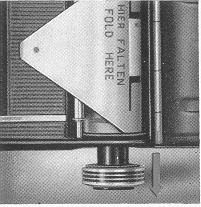
In this case, the spool must still be resting against the upper
part of the spool chamber, i.e. engaged by the carrier
mechanism.
Exchanging lenses is a quick and simple matter.
Turn milled ring ( 18) of the bayonet fitting anti-clockwise (as
seen from the front) until it stops and remove the lens from the
camera. The red mark on the scale of the lens to be inserted
must be a the top, and the screw, or pin, on the inner edge of
the lens mount has to engage in the recess in the lens seat of
the camera (see illustration). To fasten the lens tighten milled
ring (18) by clockwise movement (as seen from the front).
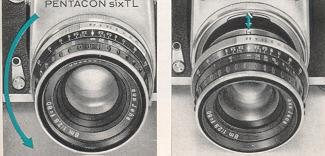
The standard lens, Zeiss Biometar 80mm f/2.8 is
equipped with automatic spring diaphragm control (ASD). No
specific handling of the lens is necessary except setting the
aperture required for the exposure. The diaphragm is
automatically controlled by the camera. During the focusing
procedure it is completely open
Supplementary lenses with automatic diaphragm
are operated in the same manner as described above for standard
lenses. This applies both to setting the diaphragm stop and to
checking the depth of field.
(e.g. PENTAGON 300 mm f/4 with manual pre-set diaphragm) are set by pressing the
setting ring directly behind the diaphragm scale towards the back and adjusting
it to bring its mark against the desired diaphragm numeral, where it clicks in.
This makes it possible also with these lenses to focus at full aperture.
Immediately before making the exposure, you turn the diaphragm ring back to the
preselected stop.
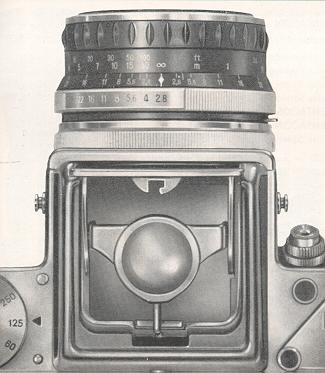
Interchangeable lenses Standard lens Zeiss Biometar 80 mm f/2.8 ASD
Supplementary lenses:
The following interchangeable lenses are
available for the PENTACON six TL:
Zeiss Flektogon 50 mm f/4 ASD
Zeiss Biometar 120 mm f/2.8 ASD
Zeiss Sonnar 180 mm f/2.8 ASD
PENTAGON (Orestegor) * 300 mm f/4 PD
PENTAGON (Orestegor) * 500 mm f/5.6 PD
Zeiss Spiegelobjektiv (Mirror Lens) 1000 mm f/5.6
ASD = automatic spring diaphragm
PD = pre-set diaphragm
* The lenses hitherto listed under the name of Meyer Optics no bear the trade
name PENTACON.
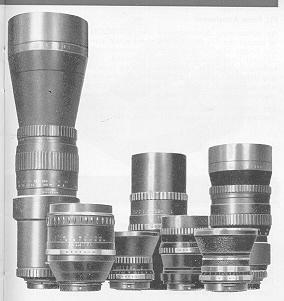
TTL Prism Attachment
An outstanding advantage of the PENTAGON six TL is its
ability to accept the TTL Prism Attachment which can be used
instead of the finder hood or the ordinary pentaprism. It
enables partially integral light metering to be performed,
based on the modern, technically accurate internal measuring
system. All factors making any difference with regard to the
exposure are automatically taken into account. Correction of
exposure values as, for instance, in close-up work or with
filters, is no longer necessary.
For further information please refer to our brochures and to
the instructions for using the TTL Prism Attachment.
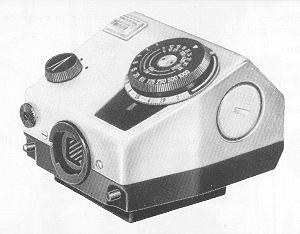
Set of Intermediate Rings
Set of Intermediate Rings with Plunger
10 mm Intermediate Ring with Plunger
Clase-up Bellows Attachment
Reversing Tube
Special Intermediate Ring with Cable Release Connection
Double Cable Release
Special Image Field Lenses
Focusing Magnifier
For further details please refer to our brochures and to the
instructions for using "Close-up Equipment for PENTACON six
and PRAKTISIX."
Accessories for the connection to the eyepiece

Additional Accessories
| The following accessories may be attached to
the eyepiece of the pentaprism and of the TTL Prism
Attachment:
Eye Cup |
Special Pressure Plate for the use of
photographic glass plates
Focusing Side Universal Tripod Filters Lens - Hoods Cable Releases One final hint with regard to setting up the camera on a
flat surface. A screw (Order Number 223650) to be threaded
into the tripod socket of the camera may be used as a third
supporting
|
The details given in this booklet are subject to slight alterations which may
result from further development in the manufacturing Process.
Please read these Instructions for Use carefully, since we can accept no
liability for damage caused by improper handling of the camera.